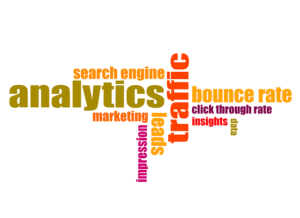
At the beginning of March when the COVID-19 lockdown was just beginning, I had a client in full blown panic mode. As an owner of vacation properties in the Finger Lakes, he was dealing with reservation cancellation after reservation cancellation and expressed his concern that if things didn’t turn around, he didn’t know how long he could stay in business at that pace.
The Numbers Don’t Lie
When it came time to put together the client’s Monthly Analytics reports at the beginning of April, I knew it was going to be utter carnage. Besides the obvious stack of cancellations on his desk telling him that business was going poorly, the website analytics would paint the picture in “black and white”.
Google analytics is something I talked about in depth in an earlier article, “Internet Marketing Tip of the Day, Set Up Your Analytics”. This free tool can provide you with  your website’s visitor insight’s and behaviors for a certain period.
your website’s visitor insight’s and behaviors for a certain period.
In my client’s case, traffic to the website was down by about 60 percent and his reservation calendars were basically empty for the Summer. While more people were online overall because of the stay-at-home rules, traffic to the travel and tourism industry type sites was down considerably. There was no getting around how bad the Reports were looking and while it was easy to blame COVID-19, the objective was to find some positive numbers within the analytics.
A Website’s Bounce Rate
While looking through the analytics for the month, the one number that had improved was the website’s Bounce Rate. Bounce Rate is the percentage of visitors who exit the website after only visiting one page. One of the goals of a website is visitor engagement. Engagement occurs when visitors are going to multiple pages on your website and spending some time on those pages. The higher a website’s Bounce Rate, the less time visitors are engaging which is then noticed by the Search Engines and they adjust the website’s relevancy in the search engine rankings.
In the client’s case, while their website traffic was way down, their Bounce Rate was actually lower that usual so what it told me was that while people weren’t actually making reservations, the people who were visiting the website were doing some “window shopping” for the day when travel restrictions would be reduced.
Without the analytics installed the client would have known that business was bad, but little else.
The Number’s Begin Looking Up in a Big Way
We all remember mid-April with almost 8 weeks of self-isolation under our belts, people began to go stir-crazy as Spring started and the family home was starting to feel smaller and State’s began lifting travel restrictions. At the same time traffic to my client’s website began to increase, reservations started coming in and the calendars were filling up. People were actually making plans to get out of the house for the Summer and with air travel still an uncertainty, “staycations” became a thing again.
Website visitor traffic in April almost doubled from the previous year and with analytics installed we could see that the “audience location” hot spots were coming from around the State of New York and specifically the larger Cities (New York City, Buffalo and Syracuse) as people were looking to get away from the crowds.
Knowing a website’s traffic locations and sources can help an owner develop a targeted marketing plan which in turn helps the budget.
COVID-19 Changed the Way People are Searching Online
Now we are in the middle of the Summer, and the client is having one of his best seasons ever. It was not because of the analytics that anyone actually found the website or decided to make a reservation, but the analytics provided insights that allowed the website owner to make more informed business decisions.
COVID-19 has changed the way people are searching online, “staycations” are in this Summer so if you are a destination website have you considered targeting population bases closer to your location?
Online retailers do you know what products your visitors are looking at or not looking at? No one thought about face masks before COVID-19 now they are being sold all over. What were once your top sellers may be lagers and you might have something else that people are looking at.
Restaurants and catering are now going with take-out and delivery and if they can open, they social distance outside and then maybe inside.
Having analytics installed on your website is part of an overall SEO strategy that can provide you with changing website visitor information and allow you to make more informed decisions and best of all analytics are Free.
TYFYS
DMC